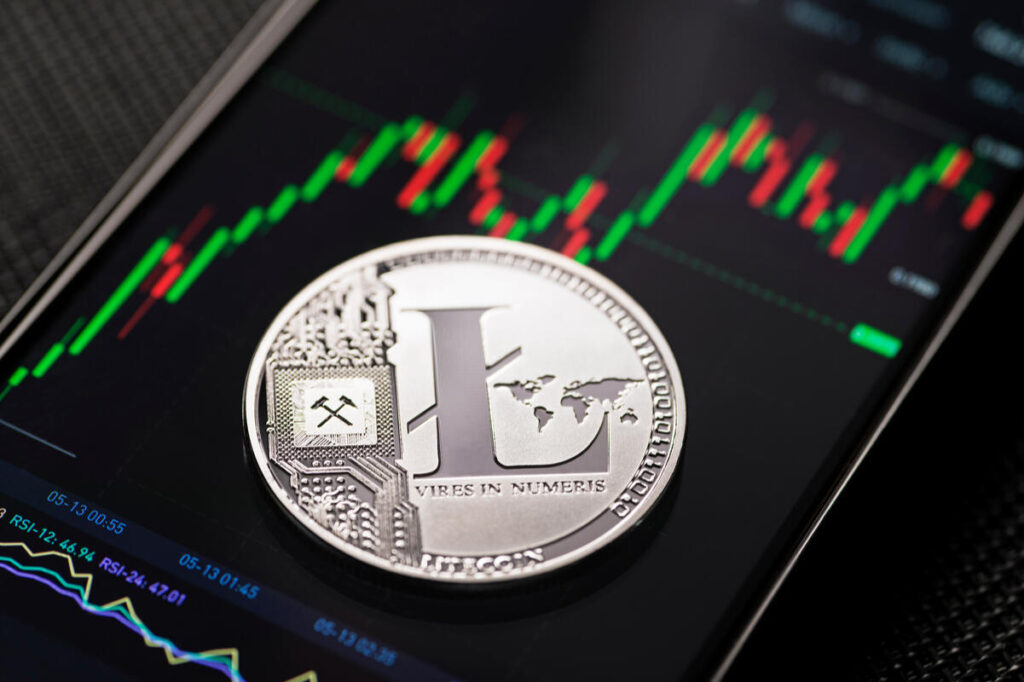
Litecoin (LTC), often referred to as the “silver” to Bitcoin’s “gold,” has been a staple in the cryptocurrency market since its inception in 2011. With its faster transaction times and lower fees, Litecoin has managed to carve out a niche for itself as a practical and widely accepted digital currency. As the cryptocurrency market continues to evolve, LTC price movements have garnered significant attention from traders and investors alike. Recently, there has been increasing speculation about whether the Litecoin price is set for a correction. This article will explore the potential for a price correction, analyze historical precedents, examine key technical indicators, and provide insights into what traders need to know to navigate these market conditions effectively.
Summary of LTC’s Recent Performance in the Market
Litecoin has experienced significant price volatility over the years, reflecting the broader trends in the cryptocurrency market. In recent months, the Litecoin price has seen a notable increase, driven by a combination of factors such as network upgrades, increased adoption, and positive market sentiment. However, with this surge in price, concerns have emerged about the potential for a market correction. Understanding Litecoin’s recent performance and the factors driving its price is essential for traders who want to make informed decisions.
In the past year, Litecoin’s price has experienced several peaks and troughs, reflecting the broader market’s fluctuations. The cryptocurrency’s value has been influenced by various factors, including the overall performance of the crypto market, technological advancements within the Litecoin network, and shifts in investor sentiment. As Litecoin’s price approached new highs, the likelihood of a correction became a topic of discussion among traders and analysts.
Historical Precedents for Litecoin
To better understand the potential for a Litecoin price correction, it is helpful to examine historical precedents. By analyzing past instances of price corrections, traders can gain insights into how the market might behave in the future and what factors could trigger a similar event.
Past Instances of LTC Price Corrections
Historically, Litecoin has experienced several significant price corrections following periods of rapid growth. These corrections have often been triggered by a combination of factors, including market sentiment, external economic conditions, and overbought technical indicators.
For example, during the 2017 cryptocurrency boom, Litecoin reached an all-time high, only to experience a sharp correction in the following months. The Litecoin price dropped by more than 50% from its peak as the broader cryptocurrency market underwent a significant retracement. This correction was largely driven by a shift in market sentiment as investors began to take profits and reduce their exposure to the highly speculative market.
Similarly, in 2019, Litecoin experienced another price correction following a substantial rally earlier in the year. After reaching a multi-year high, the Litecoin price began to decline as traders anticipated a market correction and adjusted their positions accordingly. This correction was exacerbated by broader market trends, including concerns about regulatory developments and the overall health of the global economy.
These historical precedents highlight the cyclical nature of the cryptocurrency market, where periods of rapid growth are often followed by corrections as the market seeks to establish a new equilibrium. For traders, understanding these patterns can be crucial in anticipating future price movements and managing risk effectively.

Technical Indicators to Watch
Technical analysis plays a vital role in predicting potential price corrections in the cryptocurrency market. By examining key technical indicators, traders can gain insights into the market’s current state and identify potential warning signs of an impending correction.
How Overbought and Oversold Conditions Could Affect LTC
One of the most commonly used technical indicators for identifying overbought and oversold conditions is the Relative Strength Index (RSI). The RSI measures the magnitude of recent price changes to evaluate whether an asset is overbought or oversold. Typically, an RSI value above 70 indicates that an asset is overbought, while a value below 30 suggests that it is oversold.
When Litecoin’s RSI reaches overbought levels, it may signal that the Litecoin price has risen too quickly and could be due for a correction. In such cases, traders might anticipate a pullback as the market adjusts to more sustainable levels. Conversely, when Litecoin is in oversold territory, it could indicate that the asset is undervalued and may be poised for a rebound.
Another important technical indicator to watch is the Moving Average Convergence Divergence (MACD), which helps traders identify changes in the strength, direction, momentum, and duration of a trend. When the MACD line crosses above the signal line, it may indicate a bullish trend, while a crossover below the signal line could suggest a bearish trend. In the context of a potential correction, a bearish MACD crossover could signal that the Litecoin price is losing momentum and may be heading for a downturn.
Traders should also pay attention to support and resistance levels, which represent key price points where Litecoin has historically encountered buying or selling pressure. If the Litecoin price breaks below a significant support level, it could indicate the start of a correction as sellers gain control of the market. Conversely, a failure to break above a strong resistance level might suggest that the upward momentum is weakening, increasing the likelihood of a price pullback.
Market Sentiment and Its Role
Market sentiment is another critical factor that can influence the likelihood of a price correction. Sentiment refers to the overall mood or attitude of investors and traders towards a particular asset, and it can play a significant role in driving price movements in the cryptocurrency market.
How Trader and Investor Sentiment Can Predict Corrections
Market sentiment can often act as a self-fulfilling prophecy, where positive or negative sentiment drives price movements that reinforce the prevailing mood. For example, if traders and investors are overwhelmingly bullish on Litecoin, this optimism can lead to increased buying pressure, driving up the Litecoin price. However, when sentiment becomes too euphoric, it can result in overbought conditions, increasing the risk of a correction as traders begin to take profits and reduce their exposure.
Conversely, when market sentiment turns bearish, it can lead to increased selling pressure, driving down the Litecoin price. In some cases, negative sentiment can be triggered by external factors such as unfavorable regulatory developments, economic uncertainty, or adverse news about the cryptocurrency market. When traders and investors lose confidence in Litecoin’s prospects, they may begin to sell off their holdings, leading to a price correction.
Sentiment analysis tools, such as social media monitoring and sentiment indices, can help traders gauge the overall mood of the market and identify potential turning points. By monitoring shifts in sentiment, traders can gain insights into when a correction might occur and adjust their strategies accordingly.
What Traders Need to Know
Given the potential for a price correction in Litecoin, traders must be prepared with strategies that allow them to navigate these market conditions effectively. This includes:
- Implementing risk management practices
- Timing the market
- Identifying potential opportunities during a correction.
Risk Management Strategies
Risk management is a crucial aspect of trading, especially in the volatile cryptocurrency market. One of the most effective risk management strategies is setting stop-loss orders, which automatically sell a portion or all of a trader’s holdings if the Litecoin price falls below a predetermined level. This can help protect against significant losses during a market correction.
Diversification is another important risk management strategy. By spreading investments across multiple assets, traders can reduce their exposure to any single asset’s price fluctuations. In the context of Litecoin, diversification might involve holding a mix of cryptocurrencies, as well as other asset classes such as stocks or bonds, to mitigate the impact of a potential price correction.
Traders should also consider position sizing, which involves adjusting the size of their positions based on their risk tolerance and market conditions. In a highly volatile market, it may be prudent to reduce position sizes to limit potential losses during a correction.
Timing the Market
Timing the market—predicting when to buy or sell an asset based on market conditions—can be challenging, especially in the fast-moving cryptocurrency market. However, by closely monitoring technical indicators and market sentiment, traders can improve their chances of making well-timed decisions.
During periods of rapid price appreciation, traders should be cautious about entering new positions, as the risk of a correction increases. Instead, it may be more prudent to wait for a pullback or confirmation of continued upward momentum before committing additional capital.
Similarly, if a correction appears imminent, traders may want to consider taking profits on existing positions or reducing their exposure to Litecoin. By locking in gains and waiting for the market to stabilize, traders can potentially re-enter the market at a more favorable price point.
However, it’s important to note that attempting to time the market perfectly is inherently risky, and no strategy can guarantee success. Therefore, traders should approach market timing with caution and be prepared for the possibility of unexpected market movements.
Potential Opportunities During a Correction
While price corrections can be challenging for traders, they also present potential opportunities for those who are prepared. Corrections can create buying opportunities for traders who believe in the long-term potential of Litecoin and are looking to enter the market at a lower price.
During a correction, the Litecoin price may fall to levels that are considered undervalued relative to its long-term potential. For traders with a long-term outlook, this can be an opportunity to accumulate LTC at a discount, with the expectation that the price will recover over time.
In addition to buying opportunities, corrections can also provide opportunities for traders who engage in short selling. Short selling involves borrowing an asset and selling it with the expectation that its price will decline, allowing the trader to buy it back at a lower price and pocket the difference. While short selling can be risky, it can be a profitable strategy for traders who correctly anticipate a market correction.
Another potential opportunity during a correction is to re-evaluate and adjust one’s portfolio. Corrections can serve as a reminder for traders to reassess their investment strategies and ensure that their portfolios are aligned with their long-term goals. This might involve reallocating assets, diversifying into new markets, or adjusting risk management strategies to better navigate future market conditions.
Conclusion
As the cryptocurrency market continues to evolve, the potential for a price correction in Litecoin is a topic of increasing importance for traders and investors. By examining historical precedents, monitoring key technical indicators, and understanding the role of market sentiment, traders can better anticipate and navigate potential corrections.
While corrections can be challenging, they also present opportunities for traders who are prepared and have a well-thought-out strategy. By implementing effective risk management practices, carefully timing market entries and exits, and remaining vigilant to potential buying opportunities, traders can position themselves to capitalize on market corrections.
Ultimately, the future of the Litecoin price will be shaped by a combination of internal and external factors, including technological developments, market sentiment, and broader economic conditions. As such, it is essential for traders to stay informed and adapt their strategies to the ever-changing dynamics of the cryptocurrency market. By doing so, they can better navigate the challenges and opportunities presented by potential price corrections and position themselves for long-term success in the cryptocurrency market.

